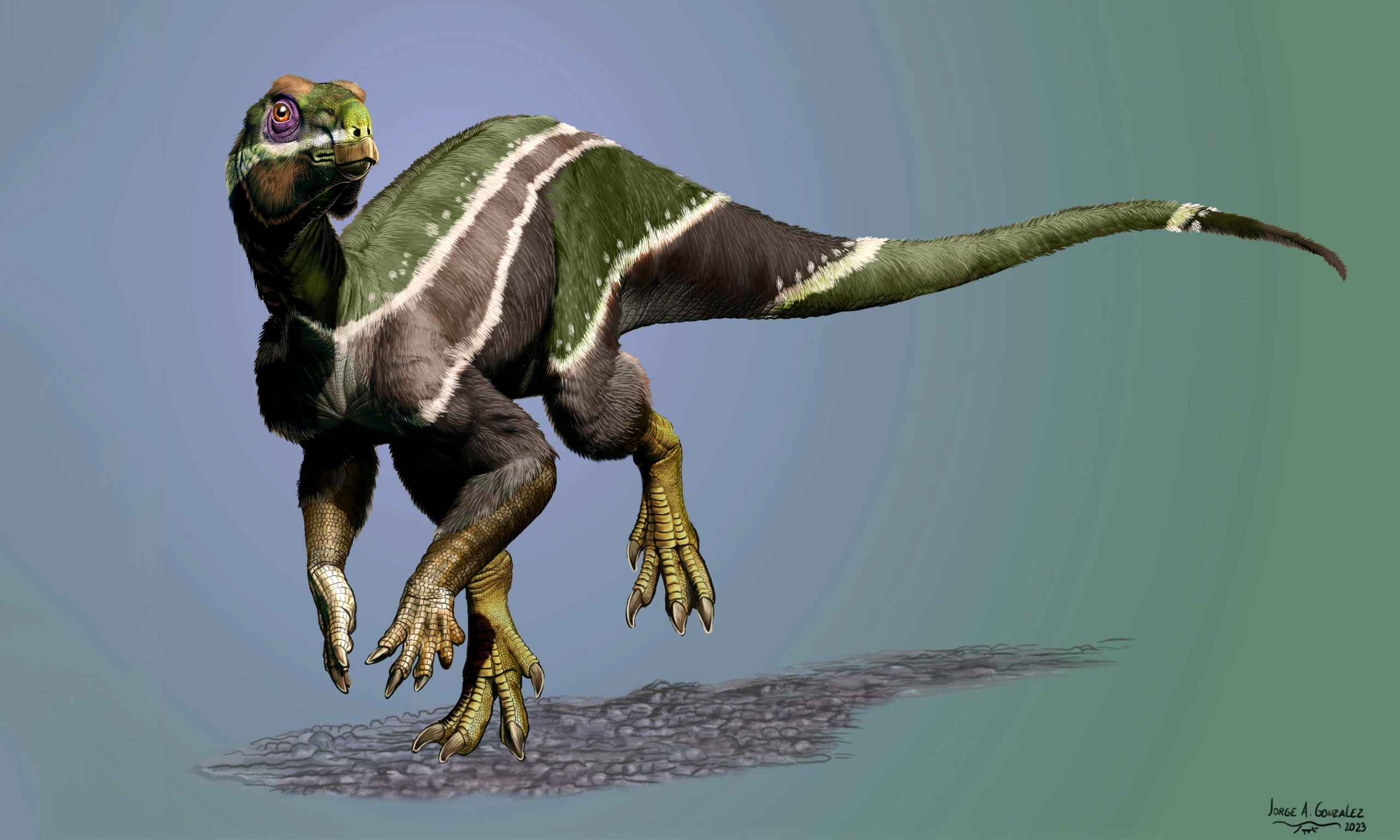Rekonstrukcja artysty Ianni Smithy. Ten niedawno odkryty wczesny dinozaur ornitopod może reprezentować ostatnie stanowisko gatunku w okresie globalnego ocieplenia w połowie okresu kredowego, około 99 mln lat temu, co doprowadziło do drastycznych zmian w populacjach dinozaurów. Źródło: Jorge Gonzalez
nowo odkryty dinozaur, Ianni SmithyŻył w okresie wstrząsów klimatycznych w środku[{” attribute=””>Cretaceous era and might be the last of its lineage, replaced by duckbill dinosaurs. This dinosaur, found in Utah, represents a critical transitional period in dinosaur history, affected by rising CO2 levels, global warming, and shifting dinosaur populations.
A newly discovered plant-eating dinosaur may have been a species’ “last gasp” during a period when Earth’s warming climate forced massive changes to global dinosaur populations.
The specimen, named Iani smithi after Janus, the two-faced Roman god of change, was an early ornithopod, a group of dinosaurs that ultimately gave rise to the more commonly known duckbill dinosaurs such as Parasaurolophus and Edmontosaurus. Researchers recovered most of the juvenile dinosaur’s skeleton – including skull, vertebrae and limbs – from Utah’s Cedar Mountain Formation.
Iani smithi lived in what is now Utah during the mid-Cretaceous, approximately 99 million years ago. The dinosaur’s most striking feature is its powerful jaw, with teeth designed for chewing through tough plant material.
Połowa kredy to czas wielkich zmian, które miały ogromny wpływ na populacje dinozaurów. Zwiększony poziom dwutlenku węgla w atmosferze w tym czasie spowodował wzrost temperatury na Ziemi i podniesienie się poziomu mórz, co spowodowało, że dinozaury zajmowały coraz mniejsze obszary lądowe. Było tak ciepło, że na biegunach kwitły lasy deszczowe. Rośliny kwitnące opanowały obszary przybrzeżne i zastąpiły naturalne źródła pożywienia roślinożerców.
W Ameryce Północnej gigantyczne roślinożerne zauropody – niegdyś tytani krajobrazu – znikały wraz z ich drapieżnymi allozaurami. W tym samym czasie z Azji przybywali również mniejsi roślinożercy, tacy jak starożytne dinozaury kaczodzioby i rogate, oraz pierzaste teropody, takie jak tyranozaury i ogromne owiraptorozaury.
wchodzi Ianni Smithyjest wyjątkowy nie tylko dlatego, że został niedawno odkryty, ale także ze względu na swoją rzadkość w północnoamerykańskim zapisie kopalnym i miejsce w historii dinozaurów.
„Odkrycie Ja To była seria szczęścia. Wiedzieliśmy, że coś takiego żyło w tym ekosystemie, ponieważ tu i tam zebrano pojedyncze zęby, ale nie spodziewaliśmy się, że natkniemy się na tak piękny szkielet, zwłaszcza z tego okresu w historii Ziemi. Posiadanie prawie kompletnej czaszki było nieocenione przy składaniu historii w całość” – mówi Lindsey Zano, profesor nadzwyczajny w[{” attribute=””>North Carolina State University, head of paleontology at the North Carolina Museum of Natural Sciences, and corresponding author of the work.

The lower jaw and teeth of new dinosaur Iani smithi. Credit: National Geographic, Mark Thiessen and Becky Hale
Zanno and her team used the well-preserved skeleton to analyze the evolutionary relationships of Iani and were surprised – and a bit skeptical – of the results.
“We recovered Iani as an early rhabdodontomorph, a lineage of ornithopods known almost exclusively from Europe,” Zanno says. “Recently, paleontologists proposed that another North American dinosaur, Tenontosaurus – which was as common as cattle in the Early Cretaceous – belongs to this group, as well as some Australian critters. If Iani holds up as a rhabdodontomorph, it raises a lot of cool questions.”
Key among these is, could Iani be a last gasp, a witness to the end of a once successful lineage? Zanno thinks that studying this fossil in the context of environmental and biodiversity changes during the mid-Cretaceous will give us more insight into the history of our planet.
Iani smithi is named for Janus, the two-faced god who symbolized transitions – an apt name, given its position in history.
“Iani may be the last surviving member of a lineage of dinosaurs that once thrived here in North America but were eventually supplanted by duckbill dinosaurs,” Zanno says. “Iani was alive during this transition – so this dinosaur really does symbolize a changing planet.
“This dinosaur stood on the precipice,” she says, “able to look back at the way North American ecosystems were in the past, but close enough to see the future coming like a bullet train. I think we can all relate to that.”
Reference: “An early-diverging iguanodontian (Dinosauria: Rhabdodontomorpha) from the Late Cretaceous of North America” by Lindsay E. Zanno, Terry A. Gates, Haviv M. Avrahami, Ryan T. Tucker and Peter J. Makovicky, 7 June 2023, PLOS ONE.
DOI: 10.1371/journal.pone.0286042
The work appears in PLOS ONE and was supported by the National Science Foundation. Zanno is lead author as well as corresponding. Terry Gates and Haviv Avrahami, both of NC State and the North Carolina Museum of Natural Sciences, along with Ryan Tucker of Stellenbosch University and Peter Makovicky of the University of Minnesota, also contributed to the work.

„Certyfikowany guru kulinarny. Internetowy maniak. Miłośnik bekonu. Miłośnik telewizji. Zapalony pisarz. Gracz.”








More Stories
Firma zajmująca się planowaniem powierzchni handlowych CADS postrzega technologię jako odpowiedź na Święta Wielkanocne i inne sezonowe wyzwania w 2024 r. — Retail Technology Innovation Hub
Astronomowie odkryli, że woda unosi się w części przestrzeni, która tworzy planetę
Tęskniłam za nim bardzo długo! Satelita NASA i martwy rosyjski statek kosmiczny zbliżają się do siebie na swojej orbicie